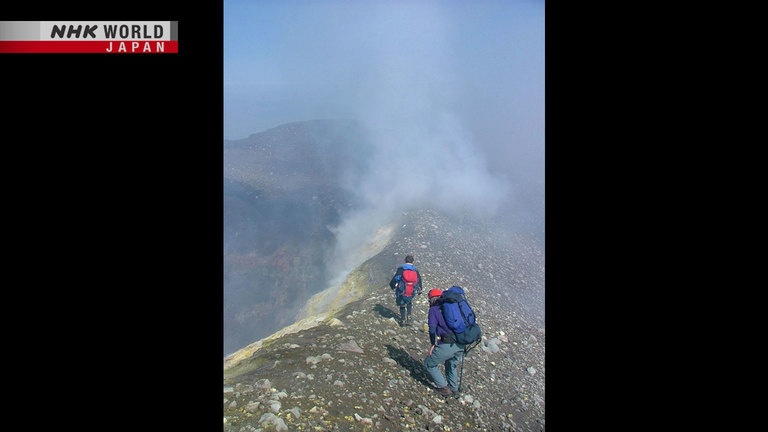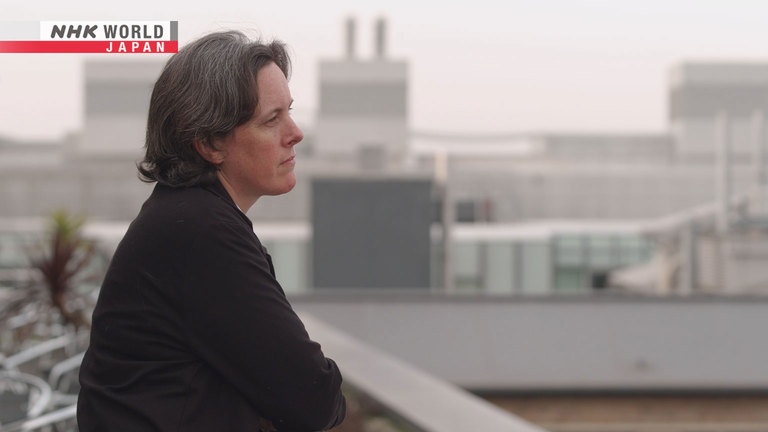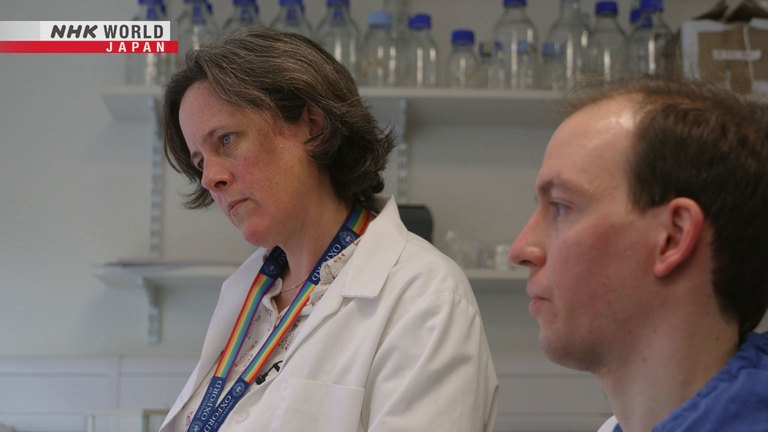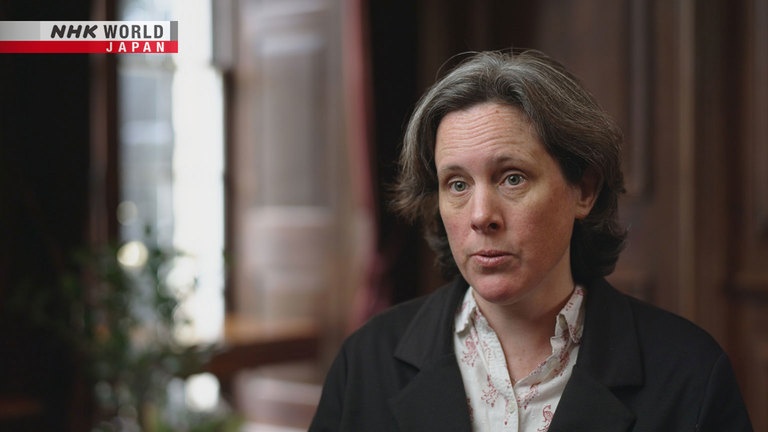Understanding Volcanoes: Tamsin Mather / Professor of Earth Sciences, Oxford University
Tamsin Mather's research into how mercury and other volcanic gases affect the atmosphere has triggered new exploration into the cause of mass extinctions of living organisms in earth's distant past.




Transcript
Direct Talk
In January 2022,
an undersea volcano near Tonga erupted,
sending a huge plume of ash
into the atmosphere.
The eruption triggered a global pressure wave
and a tsunami which caused loss of life
and livelihoods across the Pacific.
Are scientists any closer to
predicting such devastating events?
They now know more about
the chemistry behind eruptions
and they're using satellite instruments
to monitor changes inside volcanoes
and their impact on the atmosphere.
For 20 years
Tamsin Mather has been
at the forefront of this work,
analysing the gases from volcanic vents.
Direct Talk meets
the Oxford University professor
to find out about her discoveries.
Understanding Volcanoes
Most volcanic eruptions are driven by magma,
and magma rising from deep within
the planet to the Earth's surface.
And magma has various gasses
dissolve within it.
And as the pressure reduces as it rises up
through the Earth's surface,
it's a bit like
taking the lid off a fizzy drink.
And, basically if you can't get
those bubbles out of the magma,
in a quiet fashion,
they tend to expand to be ever, ever bigger,
and cause the magma to explode.
What's really interesting about this eruption
is the interaction with the seawater.
So this is one potential reason why
it was such a big explosion,
and why it pushed so much material
high up into the atmosphere.
So it's something as scientists
we are still really trying to understand -
that interaction between
the magma and the seawater
and how that governed the way
that volcano erupted.
Tonga's ash plume reached 58 km
into the stratosphere
but because of its isolation
most of the ash fell into the sea.
In 2010 a much smaller eruption on Iceland
also generated large clouds of volcanic ash.
This closed down all air travel
in europe for several weeks.
The Eyjafjallajökull eruption in 2010
blasted out a plume of pretty fine ash.
And one of the reasons we think that was
is because the volcano came up
underneath a glacier.
And so it was the melting
and then boiling of the of the ice,
that pulverized the magma even more finely.
So, the thing about the fine ash it tends to
linger longer in the atmosphere.
So, it meant that Eijafatjokull,
was able to send its plume out,
over a large area of Northern Europe
and that was the problem.
Tamsin Mather's research into volcanic plumes
began at the Masaya Volcano
in Central America in 2001.
She went there to investigate the gases that
active volcanoes emit into the atmosphere.
My PhD was concerned with understanding
the gases coming out of volcanoes
and also the particles,
including the small aerosol particles,
coming out of volcanic vents
and how they interact with
our planet's atmosphere
and the environmental effects they have.
The reason we went to Masaya in Nicaragua
is because it's degassing
all the time since the 1990s.
It's quite accessible. There's actually
a road all the way up to the top.
So you can drive all your equipment
essentially into the volcanic plume.
So you don't have to lug big car batteries
and pumps and the rest of it
up a steep sided volcano.
When you're working in
a gas plume from a volcano,
the gases are a very noxious.
So you've got a whole series of
different things within there.
But they include things like sulfur dioxide
which smells a bit like burnt matches
and then hydrogen sulfide
which is sort of your
classic rotten egg smell
that people often
associate with volcanic areas.
if you see changes in the sulfur dioxide
coming out of a volcano,
it's giving you some information about
what's going on deep, deep down,
or in the, in the system.
So, an increase influx of
sulfur dioxide, for example,
might mean that
new magma's arrived inside the volcano.
And that might mean new hazard.
Mather was also interested in how these gases
were affecting the local community
of El Panama near the crater.
They cannot use nails for example,
to fix their roofs down
because the acidic gases corrode metals away
So they tie them down with ropes.
Since the 1990s they've had to
change their farming practices.
Coffee gets very badly affected
by acidity in the environment
So they've actually switched from
growing coffee to growing things like
dragon fruit, and pineapples,
which turned out to be very resistant
to this type of fumigation.
Some of the people have problems
with breathing, irritation,
have to go inside
when you can smell the plume.
They have problems with their drinking
water supply. If they don't cover it,
getting contaminated.
Measuring sulfur dioxide levels
at active volcanoes
has become an essential tool
to help predict the risk of an eruption.
But it's also a way for aviation authorities
to track volcanic ash clouds.
Satellite measurements of sulfur dioxide
help them predict
where a volcanic plume will go.
Satellites have given us some really,
really powerful data in terms of Volcanology.
So they allow us to see our world
in a completely different way
because they allow us
to see it from the outside.
So when we are thinking
about aircraft safety,
we can look from the outside
on the really, really big scale,
and we can actually see
where the ash is going.
Tamsin Mather is the daughter
of a mathematician and a teacher
and grew up enjoying outdoor pursuits.
My first ambition was to be an astronaut.
Because of the excitement about
space travel and exploring new frontiers.
But over the years, I had grommets
so somebody told me that
I had scarred eardrums,
so I couldn't be an astronaut.
So I continued to pursue my passion
for maths and science
and ended up doing
a chemistry degree at university.
I didn't wanna do something
that was just in the lab.
I wanted to understand the world around me.
I think I'd had that sort of
moment of self-realisation of
realising that where I'm happiest
is in the great outdoors.
Studying the gases of volcanoes
has taken Mather across the world.
At Mount Etna in Sicily, known for its gases,
she collaborates with local scientists
who manage the dangers from the volcano
to the surrounding population.
On one occasion she arrived
when the volcano was erupting.
The ground was throbbing
with the pulsing magma
coming up through the system.
There was just this enormous fountain
of fire in the background.
And the sound of the lava flow
was also completely mesmerizing.
It was like a chinking chain being dragged
along the ground or breaking glass.
And, you could stand and
just sort of feel the heat,
the incredible heat of the lava flow.
Mather's goal on Mount Etna was to
measure the amount of poisonous mercury gas
that the volcano emits into the atmosphere.
She made an important scientific discovery.
So we tramped up with all this
delicate scientific equipment
and made these measurements of
how much mercury was coming out of Etna.
And one of the things that we established was
how much was coming out as particles,
how much was coming out as reactive gas
and how much was coming out as elemental gas.
And that's important because
it determines the lifetime -
how long the mercury is going to
hang about in our atmosphere.
Mather's new insights into volcanoes as a
major source of mercury in the atmosphere
came at a time when
governments were attempting
to regulate the use of mercury in industry.
We wanted to draw a baseline
so that as a global community,
we could think better about
how to regulate mercury
and how to minimize its impacts on
people all around the planet and wildlife.
The baseline proved vital.
In the 1950s and 60s,
thousands of people in Minamata, Japan
suffered birth defects
after their mothers ate fish
poisoned by mercury from a local factory.
In 2011, Mather was asked to brief policy makers
on how natural mercury
circulates in the atmosphere.
Her briefings contributed to the
United Nations' Minamata Convention
which governs the safe use of
mercury by industry.
Let's make mercury history.
Thank you very much.
And there was another unexpected outcome
to Mather's mercury findings.
In Earth's deep past
huge prolonged volcanic eruptions
have been linked to mass extinctions of life.
Could mercury levels provide the proof?
When mercury was proposed as
this new signature in the geological record,
it was not something I expected
when I'd been sitting in volcanic plumes,
making these quite tricky measurements
of mercury with colleagues.
We were making them to understand
health hazards and global impacts.
So it was really, really
unexpected to then discover
that these measurements
might be important for
something that happened
hundreds of millions of years ago.
Hey Joost. How's it going?
All good, so this is...
To test this theory
Mather and her team
are measuring mercury levels
in samples of ancient sedimentary rocks.
Mass extinction events in the fossil record
have been these periods
that have really driven change
in terms of biology on our planet.
So there are generally thought to be
what people sometimes refer to
as the big five mass extinction events.
What I'd really like to know is
what are the volcanoes doing
during those intervals of earth's history?
We now know volcanoes are
one of the major natural sources of mercury.
The mercury has a long atmospheric lifetime,
so it can end up deposited
in the very same rocks
that capture the biology,
that capture the fossils
and capture the absence of biology
that is characteristic
of mass extinction events.
Once we've powdered the rocks,
we want to find out
how much mercury is in these rocks
and what concentration of mercury there is.
So we powder it up,
and then we weigh them
into little glass boats,
and then we put the
little glass boats into a furnace
that's at many hundred degrees Celsius
and that makes the mercury
turn into a gas.
And then we draw the gas through our analyzer
and quantify,
work out, how much mercury is in that gas.
So, I'm really excited to see
what comes out of that.
High mercury levels in sedimentary rocks
found here in Scotland
date from a time of prolonged eruptions
when carbon dioxide levels were also high.
Mather believes there is a warning here.
We are running an unprecedented
experiment with our planet
in terms of the rate at which
human activities are emitting
carbon dioxide to the atmosphere.
But the planet has run
similar experiments in the past
with these very large scale,
volcanic eruptions,
these large igneous provinces,
which put out very, very large quantities
of carbon dioxide in Earth's past.
So actually by studying the consequences,
we might learn new lessons
about what our future holds.
Alongside gazing deep into the planet's past,
Tamsin Mather's work on volcanoes
is helping experts transform the way
they manage the hazards of volcanoes today.
So what we'd like to be able to do is
use satellites to measure gases
coming out of more of the world's volcanoes
so that we don't need to
instrument every single volcano
so that we can actually
build up global pictures.
There are other really important signals,
some of which
you can only get from the ground.
We can also measure the way
in which volcanoes are changing from space.
We use radar satellites
which send low energy beams
of radar waves down to the Earth's
surface and then measure what bounces back.
And by measuring what bounces back,
you can tell something about the way
that the earth is changing.
So what conclusions
does Mather draw from her research?
Take warnings and solace from nature's power.
So, when I stare into an active volcano
and all the studying that I've done
of the different impacts of volcanoes,
it reminds us, really, about
how powerful geological forces are.
But I think we also have to realise that
we are also a geological force these days.
And take solace because
I think that's that awe that you feel.
And almost that feeling of smallness
also gives me a certain inner peace
and reminds me that whatever,
however short our lives are on this planet,
the planet will prevail.
Take warnings and solace from nature's power.